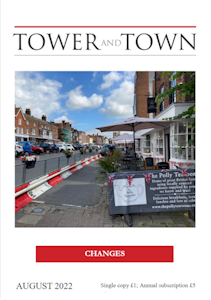

Tower and Town, August 2022 (view the full edition) (view the full edition)Nature Notes"Adventure lit their star." In 1949 journalist and broadcaster Kenneth Allsop wrote a charming book (part fact, part fiction) about a pair of Little Ringed Plovers nesting at Tring Reservoirs at the end of the War. Until 1938 when the first pair were discovered there, these small plovers were no more than rare vagrants in Britain. "Adventure lit their Star" was one of the first natural history books I read, and given the species' liking for drained or working gravel and sand pits, the title is appropriate. Allsop's book features a fictional egg-collector's foiled attempts to rob the nest and records the pair's eventual triumph over adversity and danger. The Little Ringed Plover is a small wader bird with a black and white face, yellow eye-ring and flesh-coloured legs. Compared with the similar Ringed Plover we see on sandy and shingle beaches, it is daintier, lacks the pale wing-bar and calls with a soft "pee-oo!", unlike the Ringed Plover's melodious "toolee!" Arriving in March and April in a precarious environment with trucks and bulldozers for company and water levels variable, nesting success is by no means guaranteed. The butterfly-like display flight is a delight to the eye, the male circling endlessly with slow wing-beats, calling loudly during steep ascents or vertical dives. Courtship displays are noisy, but the birds become secretive while nesting: like other plover species they sometimes resort to injury-feigning, dragging a faked broken wing to draw a potential predator away from a nest site. By August they will have left to winter in the Mediterranean and further south, recovering perhaps from a stressful breeding season. From those first nesting successes in the war years numbers have steadily risen. Birds return each year to breed in most English counties: a recent estimate suggested there are now well over 1,250 pairs. At the Cotswold Water Park pairs vary from 6 to 10 year by year, according to the availability of suitable sites, and there are one or two other locations in Wiltshire where they have bred. There are other species that have joined us through northward expansion: Cetti's Warblers, Collared Doves, Firecrests and Little Egrets. We have reintroduced the Great Bustard, reversed the decline of the Tree Sparrow and Red Kites outnumber Buzzards in our county. Alongside these gains we have witnessed the drastic reduction in native species such as the Nightingale and Turtle Dove and some of our farmland birds.
Robin Nelson |